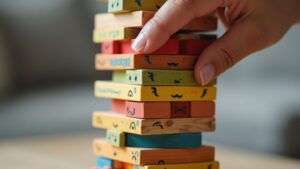Emotions Jenga turns a classic stacking game into a powerful tool for exploring feelings. Each block features a color-coded prompt, nudging players to name emotions, share experiences, or practice coping skills. Therapists and educators use it to build emotional awareness in a low-pressure way, making tough conversations feel like play. Whether in classrooms or abodes, it helps people connect with themselves and others—one wobbly block at a time. The real challenge? Keeping the tower up while keeping walls down.
Origins and Benefits of Emotions Jenga
While traditional Jenga focuses on steady hands and strategy, Emotions Jenga shifts the goal to awareness of feelings in a playful, low-pressure way. Therapists and educators helped create this game to help students and adults practice emotional literacy through interactive play.
Rather than just stacking blocks, players name emotions, discuss experiences, and build social skills—turning games into meaningful tools for mental health. Its non-threatening design makes it an ideal icebreaker, allowing even shy individuals to open up. By identifying emotions in a fun setting, people strengthen self-awareness and empathy.
Whether in classrooms or therapy sessions, Emotions Jenga supports better communication and well-being without pressure. The game proves that learning about feelings can be engaging and beneficial for all ages.
How Emotions Jenga Works
Emotions Jenga builds on the familiar setup of the classic stacking game, but with an added layer of emotional exploration. Players use a standard Jenga game, where each block is color-coded or inscribed with questions, prompts, or emotions like joy or frustration. As a player pulls a block, they read the prompt aloud and share their thoughts, making the game a tool for self-reflection.
The setup resembles color by number activities or subtraction within 20 math games—structured yet engaging. Some versions even incorporate playful fonts like Kimberly Geswein Fonts for readability. Unlike Reading Comprehension Passages, this approach blends physical play with emotional learning, helping players express feelings in a low-pressure way. The tower’s collapse mirrors releasing built-up emotions, turning tension into laughter.
Emotional Intelligence and Emotions Jenga
How can a simple game of Jenga turn into a powerful tool for emotional growth? Emotions Jenga uses the classic Jenga tower to build social-emotional skills in a playful way. Each block has prompts like “jump little look make” or “feel happy,” encouraging players to reflect on emotions as they play.
Whenever the tower falls, it’s not just a game over—it’s a chance to discuss feelings like “feel sad” or “feel happy” in a safe space. This makes it a great tool for Play Therapy, helping kids and adults alike expand their emotional vocabulary. The set creates a neutral ground for deeper conversations, strengthening empathy and self-awareness.
Applying Emotions Jenga in Various Settings
The versatility of Emotions Jenga makes it useful far beyond casual play. In therapy, it aids emotional processing by turning deep discussions into a structured activity. Classrooms benefit from its role in social-emotional learning, helping students build emotional awareness through a playful exercise. Workplaces use it for team-building, fostering trust and professional success. At home, it strengthens personal relationships by nurturing emotional bonds.
| Setting | Benefit | Keywords |
|---|---|---|
| Therapy | Encourages emotional processing | Structured activity |
| Classroom | Amplifies social-emotional learning | Playful exercise |
| Workplace | Boosts team-building | Professional success |
This adaptable tool supports well-being across diverse environments, blending fun with meaningful connection.
Creating Your Own Emotions Jenga Set
Crafting a personalized Emotions Jenga set turns a classic game into a powerful tool for exploring feelings. Using oil-based paint markers, assign colors to emotions—like red for anger or blue for calm—and paint one side of each block. Pre-write 15 questions per emotion, printing them on matching color-coded paper.
For younger players, pair prompts with First Grade Reading Comprehension or Free Kindergarten Reading Passages to build literacy. Older kids could respond to Subtract within 10 Math or Multiplication Practice Worksheets tied to emotions. Customize further with Lined Writing Paper Templates for reflections or Handwriting Practice All Year for emotional journaling.
Whether used in therapy or classrooms, this adaptable tool fosters self-awareness, blending play with growth.
Conclusion
Sometimes life feels like a wobbly tower about to topple—but just like in Emotions Jenga, losing a block doesn’t mean the game is over. Whenever sharing laughs in a coffee shop or heartfelt words in therapy, people keep pulling pieces, building resilience. Unexpectedly, even a simple game becomes a tool for healing. Connections form where they’re least expected, proving emotions—no matter how shaky—can always find steady ground when given the chance.




